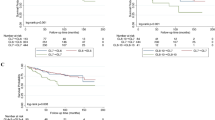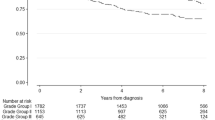Abstract
Purpose
To systematically and comprehensively review and summarize the most recent literature assessing the value of the new grading system introduced by the International Society of Urological Pathology (ISUP) in 2014 and accepted by the World Health Organization (WHO) in 2016.
Methods
A systematic literature search in the PubMed database was performed up to November 2018. Overall, 15 studies in the period from 2016 to 2018 evaluating the new grading system have been selected for evidence synthesis.
Results
The main goals of the new ISUP 2014/WHO 2016 grading system were to establish (I) a more accurate and simplified grade stratification, (II) less overtreatment of indolent prostate cancer as well as (III) an improved patient communication. The majority of the studies chose biochemical recurrence as an endpoint for evaluation and statistically assigns the new ISUP 2014/WHO 2016 grading system a higher prognostic accuracy than the former Gleason grading. However, in only a subset of studies it was clearly evident that the historical samples were not only re-grouped according to the new grade groups but also re-graded according to the new histomorphological 2014 ISUP criteria.
Conclusions
The vast majority of the studies support an improved prognostic accuracy of the ISUP 2014/WHO 2016 grade groups and endorse its worldwide application.
Similar content being viewed by others
References
Mottet N, Bellmunt J, Bolla M, Briers E, Cumberbatch MG, De Santis M, Fossati N, Gross T, Henry AM, Joniau S, Lam TB, Mason MD, Matveev VB, Moldovan PC, van den Bergh RCN, Van den Broeck T, van der Poel HG, van der Kwast TH, Rouviere O, Schoots IG, Wiegel T, Cornford P (2017) EAU-ESTRO-SIOG guidelines on prostate cancer. Part 1: screening, diagnosis, and local treatment with curative intent. Eur Urol 71(4):618–629. https://doi.org/10.1016/j.eururo.2016.08.003
Cornford P, Bellmunt J, Bolla M, Briers E, De Santis M, Gross T, Henry AM, Joniau S, Lam TB, Mason MD, van der Poel HG, van der Kwast TH, Rouviere O, Wiegel T, Mottet N (2017) EAU-ESTRO-SIOG guidelines on prostate cancer. Part II: treatment of relapsing, metastatic, and castration-resistant prostate cancer. Eur Urol 71(4):630–642. https://doi.org/10.1016/j.eururo.2016.08.002
Montironi R, Cheng L, Lopez-Beltran A, Scarpelli M, Mazzucchelli R, Mikuz G, Kirkali Z, Montorsi F (2010) Original Gleason system versus 2005 ISUP modified Gleason system: the importance of indicating which system is used in the patient’s pathology and clinical reports. Eur Urol 58(3):369–373. https://doi.org/10.1016/j.eururo.2010.04.028
Brookman-May S, May M, Wieland WF, Lebentrau S, Gunia S, Koch S, Gilfrich C, Roigas J, Hoschke B, Burger M (2012) Should we abstain from Gleason score 2-4 in the diagnosis of prostate cancer? Results of a German multicentre study. World J Urol 30(1):97–103. https://doi.org/10.1007/s00345-010-0632-5
Epstein JI, Amin MB, Reuter VE, Humphrey PA (2017) Contemporary gleason grading of prostatic carcinoma: an update with discussion on practical issues to implement the 2014 International Society of Urological Pathology (ISUP) Consensus Conference on Gleason Grading of Prostatic Carcinoma. Am J Surg Pathol 41(4):e1–e7. https://doi.org/10.1097/pas.0000000000000820
Pierorazio PM, Walsh PC, Partin AW, Epstein JI (2013) Prognostic Gleason grade grouping: data based on the modified Gleason scoring system. BJU Int 111(5):753–760. https://doi.org/10.1111/j.1464-410X.2012.11611.x
Humphrey PA, Moch H, Cubilla AL, Ulbright TM, Reuter VE (2016) The 2016 WHO classification of tumours of the urinary system and male genital organs—part B: prostate and bladder tumours. Eur Urol 70(1):106–119. https://doi.org/10.1016/j.eururo.2016.02.028
Moher D, Liberati A, Tetzlaff J, Altman DG, The PRISMA Group (2009) Preferred reporting items for systematic reviews and meta-analyses: the PRISMA statement. PLoS Med 6(7):e1000097. https://doi.org/10.1371/journal.pmed1000097)
Offermann A, Hohensteiner S, Kuempers C, Ribbat-Idel J, Schneider F, Becker F, Hupe MC, Duensing S, Merseburger AS, Kirfel J, Reischl M, Lubczyk V, Kuefer R, Perner S (2017) Prognostic value of the new prostate cancer international society of urological pathology grade groups. Front Med 4:157. https://doi.org/10.3389/fmed.2017.00157
Grogan J, Gupta R, Mahon KL, Stricker PD, Haynes AM, Delprado W, Turner J, Horvath LG, Kench JG (2017) Predictive value of the 2014 International Society of Urological Pathology grading system for prostate cancer in patients undergoing radical prostatectomy with long-term follow-up. BJU Int 120(5):651–658. https://doi.org/10.1111/bju.13857
Wissing M, Brimo F, Chevalier S, Scarlata E, McKercher G, O’Flaherty A, Aprikian S, Thibodeau V, Saad F, Carmel M, Lacombe L, Tetu B, Ekindi-Ndongo N, Latour M, Trudel D, Aprikian A (2018) Optimization of the 2014 Gleason grade grouping in a Canadian cohort of patients with localized prostate cancer. BJU Int. https://doi.org/10.1111/bju.14512
Alenda O, Ploussard G, Mouracade P, Xylinas E, de la Taille A, Allory Y, Vordos D, Hoznek A, Abbou CC, Salomon L (2011) Impact of the primary Gleason pattern on biochemical recurrence-free survival after radical prostatectomy: a single-center cohort of 1,248 patients with Gleason 7 tumors. World J Urol 29(5):671–676. https://doi.org/10.1007/s00345-010-0620-9
Kirmiz S, Qi J, Babitz SK, Linsell S, Denton B, Singh K, Auffenberg G, Montie JE, Lane BR (2018) Grade groups provides improved predictions of pathologic and early oncologic outcomes compared with Gleason score risk groups. J Urol. https://doi.org/10.1016/j.juro.2018.08.081
He J, Albertsen PC, Moore D, Rotter D, Demissie K, Lu-Yao G (2017) Validation of a contemporary five-tiered gleason grade grouping using population-based data. Eur Urol 71(5):760–763. https://doi.org/10.1016/j.eururo.2016.11.031
Mathieu R, Moschini M, Beyer B, Gust KM, Seisen T, Briganti A, Karakiewicz P, Seitz C, Salomon L, de la Taille A, Roupret M, Graefen M, Shariat SF (2017) Prognostic value of the new grade groups in prostate cancer: a multi-institutional European validation study. Prostate Cancer Prostatic Dis 20(2):197–202. https://doi.org/10.1038/pcan.2016.66
Spratt DE, Jackson WC, Abugharib A, Tomlins SA, Dess RT, Soni PD, Lee JY, Zhao SG, Cole AI, Zumsteg ZS, Sandler H, Hamstra D, Hearn JW, Palapattu G, Mehra R, Morgan TM, Feng FY (2016) Independent validation of the prognostic capacity of the ISUP prostate cancer grade grouping system for radiation treated patients with long-term follow-up. Prostate Cancer Prostatic Dis 19(3):292–297. https://doi.org/10.1038/pcan.2016.18
Epstein JI, Zelefsky MJ, Sjoberg DD, Nelson JB, Egevad L, Magi-Galluzzi C, Vickers AJ, Parwani AV, Reuter VE, Fine SW, Eastham JA, Wiklund P, Han M, Reddy CA, Ciezki JP, Nyberg T, Klein EA (2016) A contemporary prostate cancer grading system: a validated alternative to the Gleason score. Eur Urol 69(3):428–435. https://doi.org/10.1016/j.eururo.2015.06.046
Berney DM, Beltran L, Fisher G, North BV, Greenberg D, Moller H, Soosay G, Scardino P, Cuzick J (2016) Validation of a contemporary prostate cancer grading system using prostate cancer death as outcome. Br J Cancer 114(10):1078–1083. https://doi.org/10.1038/bjc.2016.86
Spratt DE, Cole AI, Palapattu GS, Weizer AZ, Jackson WC, Montgomery JS, Dess RT, Zhao SG, Lee JY, Wu A, Kunju LP, Talmich E, Miller DC, Hollenbeck BK, Tomlins SA, Feng FY, Mehra R, Morgan TM (2016) Independent surgical validation of the new prostate cancer grade-grouping system. BJU Int 118(5):763–769. https://doi.org/10.1111/bju.13488
Dell’Oglio P, Karnes RJ, Gandaglia G, Fossati N, Stabile A, Moschini M, Cucchiara V, Zaffuto E, Karakiewicz PI, Suardi N, Montorsi F, Briganti A (2017) The new prostate cancer grading system does not improve prediction of clinical recurrence after radical prostatectomy: results of a large, Two-Center Validation Study. Prostate 77(3):263–273. https://doi.org/10.1002/pros.23265
Yeong J, Sultana R, Teo J, Huang HH, Yuen J, Tan PH, Khor LY (2017) Gleason grade grouping of prostate cancer is of prognostic value in Asian men. J Clin Pathol 70(9):745–753. https://doi.org/10.1136/jclinpath-2016-204276
Schulman AA, Howard LE, Tay KJ, Tsivian E, Sze C, Amling CL, Aronson WJ, Cooperberg MR, Kane CJ, Terris MK, Freedland SJ, Polascik TJ (2017) Validation of the 2015 prostate cancer grade groups for predicting long-term oncologic outcomes in a shared equal-access health system. Cancer 123(21):4122–4129. https://doi.org/10.1002/cncr.30844
Loeb S, Folkvaljon Y, Robinson D, Lissbrant IF, Egevad L, Stattin P (2016) Evaluation of the 2015 Gleason grade groups in a nationwide population-based cohort. Eur Urol 69(6):1135–1141. https://doi.org/10.1016/j.eururo.2015.11.036
Pompe RS, Davis-Bondarenko H, Zaffuto E, Tian Z, Shariat SF, Leyh-Bannurah SR, Schiffmann J, Saad F, Huland H, Graefen M, Tilki D, Karakiewicz PI (2017) Population-based validation of the 2014 ISUP Gleason grade groups in patients treated with radical prostatectomy, brachytherapy, external beam radiation, or no local treatment. Prostate 77(6):686–693. https://doi.org/10.1002/pros.23316
Funding
AO and MCH are supported by junior research grants from University of Luebeck.
Author information
Authors and Affiliations
Contributions
AO: project development, data collection, data analysis, manuscript writing, data extraction. MCH: data collection, data analysis, manuscript writing, data extraction. VS: project development, manuscript editing. ASM: data analysis, manuscript editing. SP: project development, data analysis, manuscript editing, study supervision.
Corresponding author
Ethics declarations
Conflict of interest
The authors declare that they have no conflict of interest.
Research involving human participants and/or animals
This article does not contain any studies with human participants or animals performed by any of the authors.
Additional information
Publisher's Note
Springer Nature remains neutral with regard to jurisdictional claims in published maps and institutional affiliations.
Rights and permissions
About this article
Cite this article
Offermann, A., Hupe, M.C., Sailer, V. et al. The new ISUP 2014/WHO 2016 prostate cancer grade group system: first résumé 5 years after introduction and systemic review of the literature. World J Urol 38, 657–662 (2020). https://doi.org/10.1007/s00345-019-02744-4
Received:
Accepted:
Published:
Issue Date:
DOI: https://doi.org/10.1007/s00345-019-02744-4




